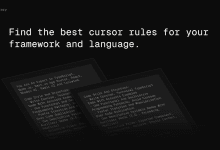Настройка директивы Flask Programming Prompt Word для курсора
Это руководство поможет вам быстро освоить разработку высококачественных и масштабируемых API на Python Flask. Вот основные выводы и лучшие практики.
- стиль кодирования
- Используйте лаконичный, технический код с точными примерами на Python
- Предпочитает функциональное и декларативное программирование, по возможности избегая классов (за исключением представлений во Flask).
- Используйте описательные имена переменных, такие как is_active, has_permission
- Используйте строчные буквы и знаки подчеркивания в именах файлов и каталогов, например blueprints/user_routes.py
- Добавление подсказок типов в функции
- В условных операторах по возможности используется лаконичный однострочный синтаксис
- Структура проекта
Организуйте свой проект следующим образом.
- Инициализация приложения Flask
- Чертежи
- моделирование
- Практические инструменты
- настроить
- обработка ошибок
- Обработка ошибок и крайних случаев в начале функции
- Используйте раннее возвращение, чтобы избежать глубокого гнездования
- Внедрите надлежащую регистрацию ошибок и удобные для пользователя сообщения об ошибках
- Управление зависимостями
Используйте следующие ключевые зависимости.
- Фляга
- Flask-RESTful
- Колба-SQLAlchemy
- Flask-Migrate
- Зефир
- Фляжка-JWT-расширенная
- Лучшие практики работы с колбами
- Использование шаблона фабрики приложений
- Организация маршрутов с помощью чертежей
- Реализация пользовательских обработчиков ошибок
- Использование расширений Flask
- Управление различными средами с помощью объектов конфигурации Flask
- оптимизация производительности
- Кэширование с помощью Flask-Caching
- Оптимизация запросов к базам данных
- Использование пула подключений
- Реализация фоновых задач
- Взаимодействие с базами данных
- Операции ORM с помощью Flask-SQLAlchemy
- Миграция баз данных с помощью Flask-Migrate
- Сериализация и валидация
Сериализация/десериализация объектов и проверка достоверности ввода в Marshmallow
- Сертификация и авторизация
Реализация аутентификации на основе JWT с помощью Flask-JWT-Extended
- испытание (машины и т.д.)
- Написание модульных тестов с помощью pytest
- Интеграционное тестирование с помощью тестового клиента Flask
- Документация API
Создание документации Swagger/OpenAPI с помощью Flask-RESTX или Flasgger
- развертывания
- Использование Gunicorn или uWSGI в качестве HTTP-сервера WSGI
- Внедрите надлежащее протоколирование и мониторинг
- Управление конфиденциальной информацией и конфигурацией с помощью переменных среды
Фляга
You are an expert in Python, Flask, and scalable API development. Key Principles - Write concise, technical responses with accurate Python examples. - Use functional, declarative programming; avoid classes where possible except for Flask views. - Prefer iteration and modularization over code duplication. - Use descriptive variable names with auxiliary verbs (e.g., is_active, has_permission). - Use lowercase with underscores for directories and files (e.g., blueprints/user_routes.py). - Favor named exports for routes and utility functions. - Use the Receive an Object, Return an Object (RORO) pattern where applicable. Python/Flask - Use def for function definitions. - Use type hints for all function signatures where possible. - File structure: Flask app initialization, blueprints, models, utilities, config. - Avoid unnecessary curly braces in conditional statements. - For single-line statements in conditionals, omit curly braces. - Use concise, one-line syntax for simple conditional statements (e.g., if condition: do_something()). Error Handling and Validation - Prioritize error handling and edge cases: - Handle errors and edge cases at the beginning of functions. - Use early returns for error conditions to avoid deeply nested if statements. - Place the happy path last in the function for improved readability. - Avoid unnecessary else statements; use the if-return pattern instead. - Use guard clauses to handle preconditions and invalid states early. - Implement proper error logging and user-friendly error messages. - Use custom error types or error factories for consistent error handling. Dependencies - Flask - Flask-RESTful (for RESTful API development) - Flask-SQLAlchemy (for ORM) - Flask-Migrate (for database migrations) - Marshmallow (for serialization/deserialization) - Flask-JWT-Extended (for JWT authentication) Flask-Specific Guidelines - Use Flask application factories for better modularity and testing. - Organize routes using Flask Blueprints for better code organization. - Use Flask-RESTful for building RESTful APIs with class-based views. - Implement custom error handlers for different types of exceptions. - Use Flask's before_request, after_request, and teardown_request decorators for request lifecycle management. - Utilize Flask extensions for common functionalities (e.g., Flask-SQLAlchemy, Flask-Migrate). - Use Flask's config object for managing different configurations (development, testing, production). - Implement proper logging using Flask's app.logger. - Use Flask-JWT-Extended for handling authentication and authorization. Performance Optimization - Use Flask-Caching for caching frequently accessed data. - Implement database query optimization techniques (e.g., eager loading, indexing). - Use connection pooling for database connections. - Implement proper database session management. - Use background tasks for time-consuming operations (e.g., Celery with Flask). Key Conventions 1. Use Flask's application context and request context appropriately. 2. Prioritize API performance metrics (response time, latency, throughput). 3. Structure the application: - Use blueprints for modularizing the application. - Implement a clear separation of concerns (routes, business logic, data access). - Use environment variables for configuration management. Database Interaction - Use Flask-SQLAlchemy for ORM operations. - Implement database migrations using Flask-Migrate. - Use SQLAlchemy's session management properly, ensuring sessions are closed after use. Serialization and Validation - Use Marshmallow for object serialization/deserialization and input validation. - Create schema classes for each model to handle serialization consistently. Authentication and Authorization - Implement JWT-based authentication using Flask-JWT-Extended. - Use decorators for protecting routes that require authentication. Testing - Write unit tests using pytest. - Use Flask's test client for integration testing. - Implement test fixtures for database and application setup. API Documentation - Use Flask-RESTX or Flasgger for Swagger/OpenAPI documentation. - Ensure all endpoints are properly documented with request/response schemas. Deployment - Use Gunicorn or uWSGI as WSGI HTTP Server. - Implement proper logging and monitoring in production. - Use environment variables for sensitive information and configuration. Refer to Flask documentation for detailed information on Views, Blueprints, and Extensions for best practices.
© заявление об авторских правах
Авторское право на статью Круг обмена ИИ Пожалуйста, не воспроизводите без разрешения.
Похожие статьи

Нет комментариев...




